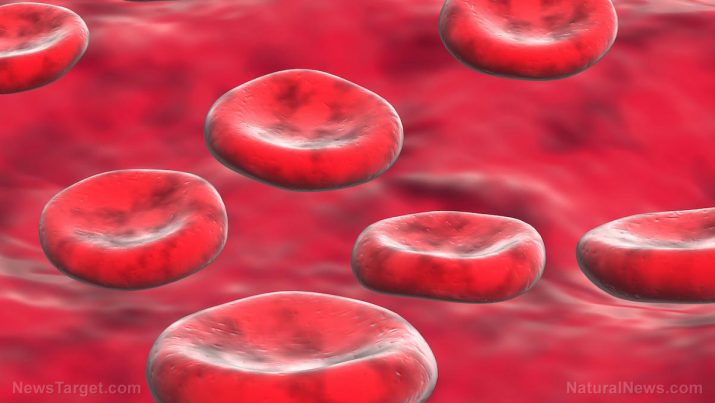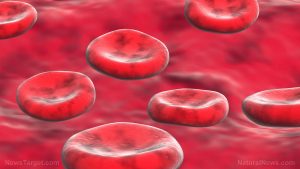
Hemochromatosis – causes, side effects and treatments at NaturalPedia.com
Tuesday, April 17, 2018 by Zoey Sky
http://www.naturalpedia.com/hemochromatosis-causes-side-effects-and-treatments-at-naturalpedia-com.html

Hemochromatosis is a genetic disorder where a patient experiences iron overload, or when there is too much iron in the body.
This inherited disorder is common among Caucasians in the U.S., and it affects at least one to six people in the country.
The normal iron content of the human body is about three to four grams, but we lose one milligram (mg) of iron daily when we sweat and shed cells from the skin and the intestines’ inner lining.
In patients with hemochromatosis, the daily absorption of iron from the intestines is more than the amount needed to replace losses. Because the normal body cannot increase iron excretion, the absorbed iron amasses in the body.
In men, the excess iron deposits in the heart, joints, liver, and testicles can damage these organs. For women, iron is accumulated at a slower rate than men because they lose more iron than the latter (e.g., during breastfeeding and menstruation). Female patients with hemochromatosis usually develop signs and symptoms of organ damage caused by excess iron 10 years later than male patients.
Hemochromatosis has two forms:
- Primary hemochromatosis – An inherited genetic disorder that causes patients to absorb too much iron from food. Most types of primary hemochromatosis occur due to mutations.
- Secondary hemochromatosis – Occurs when the buildup of iron is caused by other medical conditions like anemia, chronic liver disease, frequent blood transfusions, or kidney dialysis.

Known side effects and risk factors of hemochromatosis
Most patients with hemochromatosis don’t experience side effects. When individuals do have symptoms, they may vary per person.
The symptoms of hemochromatosis include:
- Abdominal pain
- Fatigue
- Impotence
- Joint pain
- Low energy
- A low sex drive
Risk factors for developing primary hemochromatosis may include:
- Having a close relative with the disorder
- Being of European descent
- Gender – Postmenopausal women are at increased risk.
- Both men and women may inherit the disorder, but according to the Centers for Disease Control and Prevention (CDC), men have a higher chance of developing the disease.
Take note that not all people who inherit the gene mutation for hemochromatosis will develop the disease. Some are only are carriers, or they have the gene do not experience any symptoms.
Risk factors for secondary hemochromatosis may include:
- Alcoholism
- A family history of diabetes, heart disease, or liver disease
- Taking dietary supplements that contain iron or vitamin C – These can increase the amount of iron absorbed by the body.
Body systems harmed by hemochromatosis
Hemochromatosis may cause the following complications:
- Circulation problems – May cause heart failure.
- Excess iron – May cause the skin to turn bronze/gray.
- Iron buildup in the heart – May cause irregular heart rhythm.
- Liver damage – May cause permanent scarring of the liver (cirrhosis).
- Pancreatic damage – May cause changes in insulin levels which can result in diabetes.
Food items or nutrients that may prevent hemochromatosis
These foods and nutrients can help patients with hemochromatosis reduce their iron absorption:
- Calcium
- Green tea
- Milk thistle
- Oxalates and phytates
- Polyphenols and tannins
- Turmeric
Diet recommendations for people with hemochromatosis include:
- Avoiding alcohol – Alcohol consumption increases the risk of developing cirrhosis and liver cancer.
- Avoiding seafood – Patients with hemochromatosis must refrain from eating raw seafood because they may acquire bacterial infections that thrive in an iron-rich environment.
- Following a normal balanced diet – There is no need to avoid food that contains iron as long as patients are going through effective therapeutic phlebotomy.
- Managing vitamin C intake – High doses of vitamin C in individuals with iron overload can cause severe abnormal heart rhythms.
Treatments, management plans for hemochromatosis
Hemochromatosis is often treated via phlebotomy, or through the removal of blood from the body. This procedure is usually done regularly to eliminate excess iron.
When patient first begins the treatments, phlebotomy is done at least twice a week. Once initial treatments are done, a patient has to be treated four to six times yearly.
Where to learn more
- Best Supplements – Iron Linked to Lower Risk of ASD for Children
- Cloves are the Best Antioxidant, Says New Study
- Iron and copper cause oxidative damage in liver
- NaturalNews issues consumer alert about Adya Clarity, imported as battery acid and sold for internal consumption
- Young man with end stage heart failure found to have too much iron in his blood; successfully reversed with chelation therapy
Summary
Hemochromatosis is a genetic disorder where a patient experiences iron overload, or when there is too much iron in the body.
Hemochromatosis has two forms. Primary hemochromatosis is an inherited genetic disorder that causes patients to absorb too much iron from food. Most types of primary hemochromatosis occur due to mutations. Secondary hemochromatosis occurs when a buildup of iron is caused by other medical conditions like anemia, chronic liver disease, frequent blood transfusions, or kidney dialysis.
Some symptoms of hemochromatosis include abdominal pain, fatigue, impotence, joint pain, low energy, and a low sex drive.
Hemochromatosis may cause complications like circulation problems, excess iron, iron buildup in the heart, liver damage, and pancreatic damage.
Calcium, green tea, milk thistle, oxalates and phytates, polyphenols and tannins, and turmeric can help patients with hemochromatosis manage their symptoms.
Hemochromatosis is often treated via phlebotomy, or through the removal of blood from the body. This procedure is usually done regularly to eliminate excess iron.
Sources include
Tagged Under: Tags: hemochromatosis





